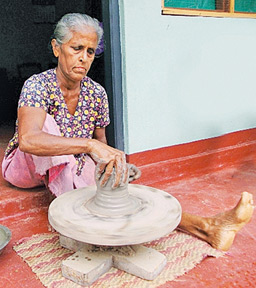The potter's wheel slows down
by K.K.D. Premalal -Matugama Special Cor
From time immemorial people have been engaging in traditional
industries such as mat weaving, jaggery making and pottery. Pottery has
a very long history running back to many centuries. Even the royal food
was prepared in earthen vessels.
 |
|
M. Laina making pottery
using her manual saka poruwa. |
Pottery was a household industry in some villages. In the past all
the earthen products were turned out by them and they made a decent
living by selling their products.
However, nobody can paint a rosy picture about the pottery industry
today. It was once a profit making venture but today it is in dire
straits mainly due to lack of clay and modern technology.
There are many clay products made by potters. Some of them are
nebiliya - used to sift stones from rice, meti koppe - a plate,
karamudiya - a lid, koraha - a basin, ethiliya - used to cook curries,
gurulettuwa - a goblet to hold water and the vase to put flowers.
Synthetic ware
Because of the availability of synthetic wares, people have distanced
themselves from pottery products. Modern day housewives use synthetic
cooking ware because they can save time and energy. When they use
earthen ware they have the difficulty in finding firewood. When using
earthen ware, the walls of the kitchen also get blackened.
It is a fascinating scene to watch how pottery is made. Most of the
pottery is made on a rotating disk that the potter keeps turning with
his experienced hands.
First a lump of clay is placed on the wheel and then the potter
moulds it. The potter's wheel or saka poruwa is now idling for want of
clay.
Ridiwita, Lindagahamula is a sleepy village not very far from
Meegahatanne in the Agalawatte electorate of the Western Province.
People in the past were involved in the pottery trade. But many people
have given it up. M. Laina who has been a potter for several decades
said, "I still like to engage in this trade, but due to lack of clay I
have stopped turning out pottery."
Income
"Apart from that, the income generated from this job is minimal. The
young people seek other employment opportunities in the garment
factories and tea estates. However, we can engage in this trade provided
we are given clay of good quality. We bring clay from Pelawatte.
However, the day is not of good quality.
She also said her neighbours carried clay pots and pans to the
village before using a pingo. In the past the pingo man was a common
sight in villages. He not only carried pots and pans but also fish and
vegetables. Laina said their lifestyle has been changed drastically
during the past two decades. She laments the slow death of the
traditional cottage industry which helped them eke out a living. Today
most of the children pursue their higher studies.
Once they complete their studies, they usually find some other
employment or are eager to seek greener pasture.
She still turns out clay toys using her manually-operated Saka Poruwa.
She also makes clay lamps (Meti Pahan) during Vesak and Poson festival.
There is a big demand for clay pots and pans before the New Year.
There is also a rush for earthen ware before Sinhala and Hindu New Year.
A pottery seller in Waskaduwa said the demand for clay pots and pans
has dropped drastically. He also said selling them has become a seasonal
business.
"If people know the value of earthen ware, they will certainly buy
them," he said.
A housewife said, I am employed in a private firm in Colombo. I have
to get up early in the morning to prepare meals. It is quite easy to
prepare a quick meal using synthetic wares. The women who are confined
to their homes can use earthen ware to prepare their meals as they have
enough time to do cooking. Apart from that she cannot find firewood
easily.
Harmful
Dr. T. Kirubendran a doctor working in a government hospital, said
clay pots and pans are better than synthetic-ware. He said clay is a
natural substance and it is not harmful to humans. Medical research
reveal that aluminium containers are harmful.
It is one of the main causes of cancer and kidney related ailments.
However, the earthenware has been exiled from the kitchen by synthetic
cooking-wares in the recent past due to diverse reasons. One
disadvantage of earthenware is it takes time and more fuel to cook. It
is evident that the ancient pottery industry is on the verge of
extinction and it is high time to encourage people to engage in this
trade. The government can play a major role by giving them required
machinery, helping them to sell their products and give incentives. |

